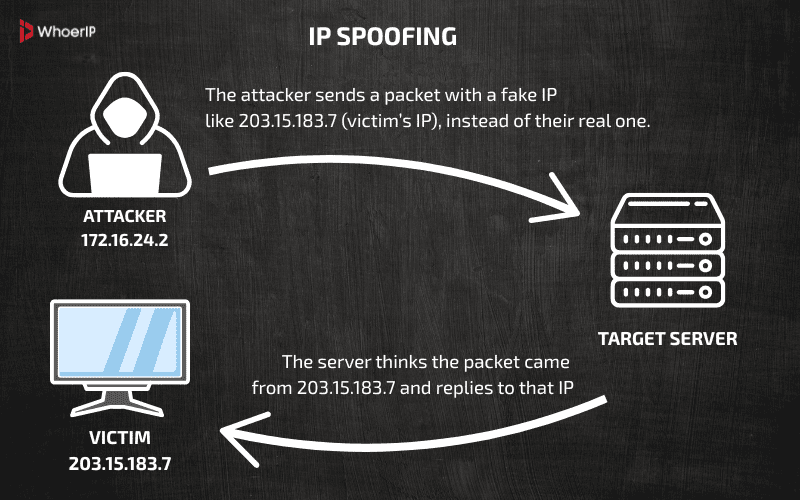So, What’s IP Spoofing, Really?
Here’s the simplest way to picture it: Someone is faking your IP address to pretend they’re you online.
Imagine this — someone mails a package with your name and your return address on it. You had nothing to do with it. But whoever gets that package? They think it came from you. That’s basically what hackers do with your IP.
Hint. Check your router’s settings for security alerts. Many modern routers can ping your phone if they notice something sketchy. Turn those on. You’ll thank yourself later.
They swap out their real IP address for yours, tricking systems into believing their traffic is legit. This lets them dodge security checks, steal data, mess with websites, or even launch attacks on others — all while wearing your digital identity.

It’s shady. It’s silent. And if you don’t know what to look for, you won’t even know it’s happening.
How Do You Actually Stop IP Spoofing?
Good news — you don’t need a computer science degree to protect yourself. But you do need to lock things down smartly. Here’s how:
- Control What Comes In and Goes Out (Packet Filtering). Imagine your router acting like a security guard at the door. It checks every packet of data coming in or going out. If something looks off — like an IP address that doesn’t match — it blocks it right away.
- Lock Both Entrances and Exits (Ingress and Egress Filtering). It’s not just about stopping bad traffic from getting in. You also need to make sure nothing suspicious leaves your network. It’s like putting locks on both the front and back doors.
- Add Proof of Identity (Authentication Tools). Tools like IPsec make sure every connection is legit. Think of it as a digital handshake — if the other side can’t prove who they are, they don’t get in. Simple as that.
- Keep an Eye on Everything (Network Monitoring). Pay attention to strange behavior on your network. A sudden traffic spike or an unfamiliar device could mean someone’s hijacking your IP. Spotting it early is key.
- Update, Update, Update (Regular Software Updates). Old software is full of security holes hackers love to exploit. Keep your router, firewall, and all connected devices updated. It’s one of the easiest ways to stay safe.
- Let In Only the Right People (Restrict Access). Set your network to allow only trusted devices or IP addresses. No reason to leave it open for strangers. The tighter your access rules, the safer you are.
Just so you know — most everyday users aren’t directly targeted by IP spoofing. But their devices can still get hijacked and secretly used in bigger attacks, all without them realizing it.
Top 5 Signs You’re a Victim of IP Spoofing
1. Unusual Network Traffic
If you notice a sudden spike in your network traffic, it could be a red flag. Attackers often use spoofed IP addresses to flood your network with a lot of traffic in what’s known as a Distributed Denial-of-Service (DDoS) attack. This can slow down your internet connection or cause complete network failures.
What to watch for:
- A noticeable drop in your internet speed
- Sudden, unexplained data usage
- Alerts from your internet service provider about unusual activity
2. Unauthorized Account Access
Cybercriminals don’t need to know your password to get into your accounts—they might use a spoofed IP address to trick security systems. If you notice that someone’s using your IP address to access your accounts, you might be dealing with spoofing.
What to watch for:
- Login alerts from strange locations
- Password reset requests you didn’t ask for
- Unfamiliar changes to your account settings
3. Emails Flagged as Spam
If your emails are suddenly being flagged as spam, it might be because your IP reputation has been damaged by spoofing. Attackers can use a spoofed IP to send out phishing emails, which tarnishes the reputation of the IP address they’re using.
What to watch for:
- A lot of your emails bouncing back
- Reports that your emails are landing in recipients’ spam folders
- Alerts from your email provider about suspicious activity
4. Firewall Alerts About Duplicate IPs
Your firewall is usually the first line of defense against spoofing. If it detects duplicate IP addresses or sees suspicious activity coming from your IP, it could be a sign that someone’s using a spoofed version of your IP.
What to watch for:
- Logs showing conflicting IP addresses
- Security alerts about unauthorized access attempts
- Warnings about mismatched source and destination IPs
5. Problems Accessing Online Services
If your IP address gets blacklisted due to spoofing, you may have trouble accessing websites, logging into online accounts, or completing transactions. It’s a frustrating situation, but it can happen if your IP has been compromised.
What to watch for:
- Restricted access to certain websites
- Notifications that your IP has been blacklisted
- Difficulty logging into secure platforms
How to Protect Yourself from IP Spoofing
Now that you know the signs, it’s time to take action. The good news is there are several steps you can take to protect yourself and your network from IP spoofing.
1. Enable Packet Filtering
Packet filtering is a simple but effective way to block spoofed packets from entering your network. This method checks the source and destination IP addresses to ensure they match up and only lets legitimate traffic through.
How to do it:
- Configure your router or firewall to filter packets based on IP addresses
- Set up Access Control Lists (ACLs) to only allow traffic from trusted sources
2. Implement Strong Authentication
One reason spoofing works is because attackers exploit weak authentication systems. You can make it much harder for them by using stronger authentication methods.
What to do:
- Use multi-factor authentication (MFA) wherever possible
- Implement network-level authentication for sensitive systems
- Regularly update passwords and choose complex combinations
3. Monitor Your Network Activity
Keeping an eye on your network activity helps you spot suspicious traffic before it becomes a bigger problem. With continuous monitoring, you can catch unauthorized access attempts early.
Tools to use:
- Network monitoring software like SolarWinds or Wireshark
- Set up alerts for unusual activity, like login attempts from unknown locations
- Regularly check your firewall and router logs
4. Use Antidetect Browsers for Extra Privacy
If you’re worried about privacy and preventing online tracking, antidetect browsers are a great tool. These browsers can mask your digital fingerprint (including your IP address) to make it much harder for attackers to spoof your online identity.
How they help against IP spoofing:
- Masking IP Addresses: By using a VPN or proxy, antidetect browsers help keep your real IP address hidden.
- Preventing Fingerprinting: These browsers make it harder for attackers to track your online activity by blocking fingerprinting techniques.
- Improved Security: They add an extra layer of protection by hiding your true location and device information.
Popular antidetect browsers:
Using an antidetect browser along with a VPN and strong authentication can significantly improve your security.
5. Secure Your Devices
It’s important to make sure all your devices are secure to protect against IP spoofing. A compromised device can give attackers easy access to your network.
What to do:
- Install antivirus software and keep it updated
- Enable automatic updates for your operating system and apps
- Avoid clicking on suspicious links or downloading files from untrusted sources
Additional Tips to Prevent IP Spoofing
1. Strengthen Your DNS Security
An often overlooked security measure is DNS (Domain Name System) security. Cybercriminals may target unsecured DNS servers to redirect traffic or carry out spoofing attacks. Securing your DNS can help prevent this.
How to do it:
- Use DNSSEC (Domain Name System Security Extensions) for added verification
- Regularly check DNS records for unauthorized changes
- Choose a reliable DNS provider with robust security features
2. Invest in Network Security Hardware
Network security appliances, like Unified Threat Management (UTM) devices, offer an all-in-one solution to protect against IP spoofing. These devices integrate firewalls, intrusion detection systems, and other security tools into one powerful package.
Advantages of UTMs:
- Real-time monitoring for suspicious activity
- Built-in packet filtering to catch spoofed IP addresses
- Regular updates to keep up with emerging threats
Investing in a UTM device gives you peace of mind knowing your network is protected by multiple layers of defense.
The Long-Term Consequences of Ignoring the Spoofing Issue
While IP spoofing might seem like a technical nuisance, ignoring it can lead to long-term consequences that go far beyond temporary network disruptions. The ripple effects of a spoofing attack can impact your personal and professional life, leaving you vulnerable to bigger problems down the line.
1. Damage to Your Online Reputation
Cybercriminals using your spoofed IP address for malicious activities, such as phishing scams or spam campaigns, can destroy your online reputation. This can result in your IP address being blacklisted, making it difficult to access services or communicate effectively. For businesses, this can mean a loss of customer trust and a tarnished brand image.
2. Financial Losses
If attackers use your spoofed IP to gain access to sensitive financial data, the consequences can be devastating. Unauthorized transactions, fraudulent purchases, and even full-scale identity theft are real possibilities. Businesses, in particular, may face hefty costs due to downtime, ransom payments, or compliance violations.
3. Persistent Security Vulnerabilities
Once your IP address has been targeted, it may continue to be exploited unless proper safeguards are implemented. Attackers who successfully spoof your IP may also use the information they gather to launch future attacks, such as credential stuffing or targeted phishing attempts.
4. Legal and Compliance Issues
If your spoofed IP is linked to criminal activity, you could face legal consequences or an investigation until you prove your innocence. Organizations, especially those handling sensitive data, may also face fines or penalties for failing to protect their networks.
Conclusion
IP spoofing is a serious cybersecurity threat that can harm your online reputation, disrupt your network, and expose you to data breaches. Recognizing the signs early and implementing robust security measures can help you protect yourself from these attacks.
By using tools like packet filtering, strong authentication, and antidetect browsers, you can safeguard your digital identity and ensure your online activities remain private and secure. Additionally, securing your DNS, investing in network security hardware, and educating your team about cybersecurity are proactive steps to reduce your risk of falling victim to spoofing.
Frequently Asked Questions
Can IP spoofing be traced?
Tracing IP spoofing can be difficult because the attacker is using a fake IP address. However, in some cases, advanced network monitoring and packet analysis might help identify the attacker's real IP, though this can require significant effort and technical expertise.
Can local IP be spoofed?
Yes, local IP addresses can be spoofed. However, local IP spoofing typically occurs within a local network, and it's harder to execute successfully due to router configurations and firewall protections that limit such attacks.
Does VPN use IP spoofing?
No, a VPN does not use IP spoofing. Instead, it masks your real IP address by routing traffic through a server, effectively hiding your real location but not using a fake IP address in a malicious manner. It is used for privacy and security, unlike spoofing, which is typically used for malicious purposes.
Can IP spoofing be stopped?
Yes, IP spoofing can be stopped by implementing several security measures, such as: 1. Packet filtering to block spoofed packets. 2. Strong authentication methods, like multi-factor authentication (MFA). 3. Monitoring network activity with network monitoring tools. 4. Using antidetect browsers and secure devices to hide real IP addresses.
















